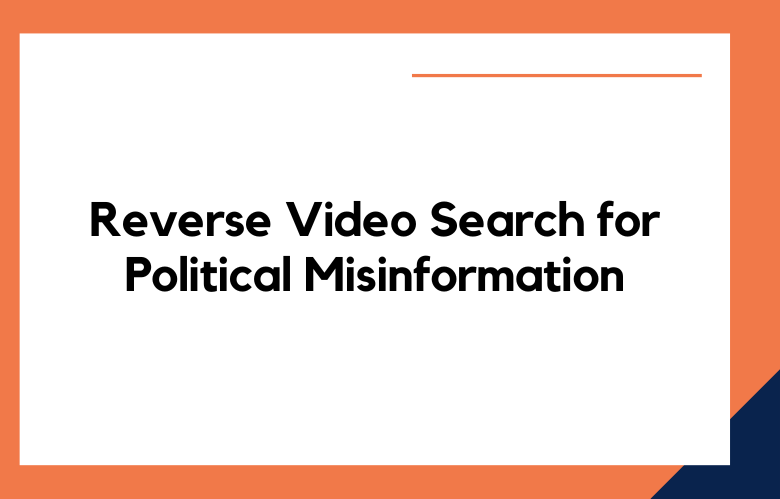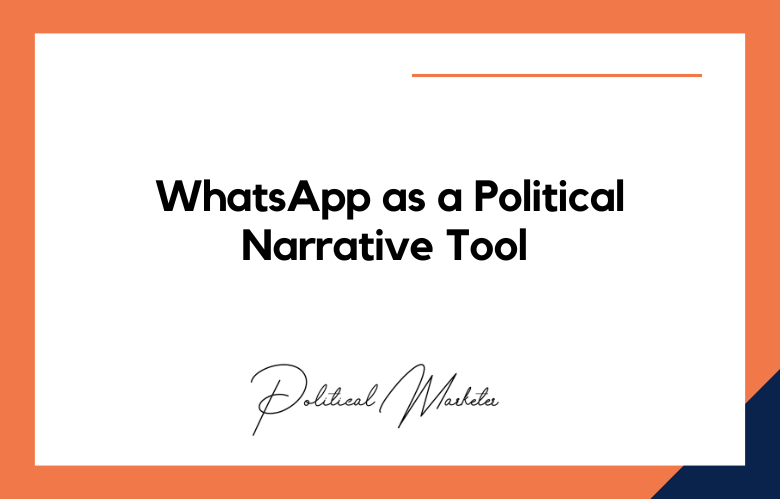In today’s digital age, political misinformation has emerged as a formidable challenge, particularly in politics, where narratives can shape public opinion and influence critical decision-making processes.
As misinformation proliferates across various media platforms, from social networks to news outlets, the need for practical tools to combat its spread has never been more urgent.
How to Use Reverse Video Search to Find Political Misinformation
Enter reverse video search — a powerful technique that flips the script on misinformation by enabling users to trace the origins of video content and verify its authenticity. In this exploration, we delve into the innovative application of reverse video search as a potent weapon in the battle against political misinformation.
Join us as we unravel the complexities of this cutting-edge technology and its transformative potential in safeguarding the integrity of political discourse. From identifying manipulated footage to debunking false claims, reverse video search empowers users to peel back the layers of misinformation and uncover the truth beneath.
As we navigate the intricacies of reverse video search, we’ll explore its practical applications, limitations, and ethical considerations. From detecting deepfakes to tracing the dissemination pathways of misleading content, this tool equips researchers, journalists, and concerned citizens with the means to hold misinformation accountable.
Uncovering Political Misinformation: A Guide to Reverse Video Search
Reverse video search is a powerful tool that can help expose political deception online. By allowing users to search for the source of a video and identify any alterations or manipulations, reverse video search can help reveal the truth behind misleading or false political content. Here are some tips for mastering reverse video search and using it to expose political deception online:
Use a reputable reverse video search engine.
Several reverse video search engines, such as Google Reverse Image Search, TinEye, and Yandex, are available online. Choose one that is known for its accuracy and reliability.
Check the video’s metadata.
When conducting a reverse video search, check the video’s metadata, which can provide valuable information about the video’s origin and history. Look for details such as the video’s upload date, the source, and any alterations that may have been made.
Look for inconsistencies
When comparing the original video with the altered version, look for inconsistencies or anomalies that may indicate deception. Pay attention to details such as the lighting, background, and audio quality, and look for any signs of tampering or manipulation.
Verify the video’s context.
Political deception often involves taking a video out of context to create a misleading impression. Be sure to verify the video’s context and consider the broader circumstances in which it was made and shared.
Consult multiple sources
It’s important to consult multiple sources when conducting a reverse video search to ensure accuracy and objectivity. Compare the results of different reverse video search engines and consider other sources of information such as news articles and fact-checking websites.
Mastering Reverse Video Search: Exposing Political Deception Online
In an era marked by the rampant spread of misinformation, particularly in the political realm, mastering reverse video search emerges as a potent tool for uncovering deceit. This paper delves into the significance of reverse video search in identifying and exposing political deception online.
This study elucidates how reverse video search can be a formidable weapon against the proliferation of falsehoods in the digital landscape by dissecting its methodologies, applications, and challenges.
Drawing upon real-world examples and case studies, this paper underscores the critical role of reverse video search in safeguarding the integrity of information and promoting transparency in political discourse. From deepfakes to selectively edited footage, this paper explores various forms of deception and elucidates how reverse video searches can effectively unravel them.
Moreover, it discusses the implications of its findings for policymakers, journalists, fact-checkers, and the general public, advocating for greater awareness and utilization of this indispensable tool in the fight against political deception online.
The Power of Reverse Video Search in Identifying Political Misinformation
In the digital age, political misinformation can spread rapidly across social media platforms, distorting public perceptions and undermining democratic discourse. However, reverse video search is a powerful tool that can help identify and expose political misinformation.
Reverse video search is a technique that allows users to find the source of a video by using a still image or a clip from the video. By identifying the source, reverse video search can help reveal any alterations or manipulations that may have been made to the video to create a misleading impression.
The power of reverse video search lies in its ability to cut through the online noise and disinformation surrounding political discourse. By providing a quick and easy way to verify a video’s authenticity, reverse video search can help promote transparency and accountability in the digital age.
Sleuthing Out Fake News: Using Reverse Video Search for Political Truth
In an era of rampant political misinformation and fake news, it’s more important than ever to have tools to help discern fact from fiction. One such tool is reverse video search, a technique that allows users to identify the source of a video and verify its authenticity.
Reverse video search works by using a still image or a clip from a video to search for similar content online. This can help identify the source of the video and any alterations or manipulations that may have been made to create a misleading impression.
Using reverse video search, citizens can become digital sleuths, unmasking fake news and political deception. This is especially important in political campaigns, where misinformation can significantly impact public opinion and voting behavior.
Navigating the Digital Landscape: Reverse Video Search for Political Misinformation
In today’s digital landscape, political misinformation is rampant, making it difficult to discern fact from fiction. However, tools are available to help us navigate this complex terrain, including reverse video search.
Reverse video search is a technique that allows users to identify the source of a video by using a still image or a clip from the video. This can help reveal any alterations or manipulations that may have been made to the video to create a misleading impression.
Using reverse video search, citizens can become more informed and discerning consumers of political information. This is especially important in political campaigns, where misinformation can significantly impact public opinion and voting behavior.
However, it’s important to note that reverse video search is just one tool in the fight against political misinformation. Media literacy, critical thinking, and fact-checking are essential for navigating the digital landscape.
Revealing Deceptive Tactics: How to Use Reverse Video Search for Political Clarity
In today’s era of digital connectivity, political discourse and information dissemination have reached unprecedented levels of influence. However, alongside the benefits of instant communication, a darker side is characterized by the proliferation of political misinformation and deceptive tactics. Manipulated videos, deepfakes, and out-of-context clips have become potent weapons in shaping public opinion and sowing discord.
The need for tools to combat political deception is more pressing in this landscape than ever. One such tool gaining prominence is reverse video search. Similar to its counterpart in image analysis, reverse video search empowers users to uncover the truth behind politically charged videos, revealing their origins, context, and authenticity. By peeling back the layers of deception, reverse video search stands as a beacon of clarity in the murky waters of online discourse.
This article explores the transformative potential of reverse video search in politics. From identifying manipulated content to tracing the spread of misinformation, we delve into the intricacies of this technology and its applications in promoting transparency and accountability.
By harnessing the power of reverse video search, individuals, journalists, and policymakers can navigate the digital landscape with clarity and discernment, safeguarding the integrity of democratic discourse.
Conclusion
Utilizing reverse video search to detect political misinformation is a promising approach in the fight against disinformation. By analyzing videos in reverse, researchers and fact-checkers can uncover the content source, track its dissemination across platforms, and identify instances of manipulation or deceptive editing.
This technique allows for a more comprehensive understanding of the context in which misinformation spreads and empowers users to make informed decisions about the content they consume.
However, reverse video search must be complemented by other methods, such as content analysis and verification techniques, to ensure accuracy and reliability in identifying and debunking political misinformation. Additionally, fostering digital literacy and critical thinking skills among the public remains crucial in combating the proliferation of false information online.
Call: +91 9848321284
Email: [email protected]
How to Use Reverse Video Search to Find Political Misinformation: FAQs
What Is Reverse Video Search In The Context Of Political Misinformation?
Reverse video search is a method used to trace the origin of a video by uploading a clip or frame to a search engine or tool that identifies where and when it has appeared online, helping verify authenticity.
How Does Reverse Video Search Help Detect Political Misinformation?
It helps uncover if a video has been reused out of context, manipulated, or falsely associated with an event or individual in political narratives.
What Are The Best Tools For Conducting A Reverse Video Search?
Key tools include Google Lens (via screenshots), InVID, Amnesty YouTube DataViewer, and RevEye, which allow users to check video frames or metadata across platforms.
Can Reverse Video Search Identify Deepfakes In Politics?
While it can’t directly detect deepfakes, reverse video search helps detect a clip’s source and highlight discrepancies, which can signal manipulation.
How Can You Extract Keyframes For Reverse Video Search?
Tools like InVID let users extract thumbnails or keyframes from videos, which they can then upload to image search engines to trace their source.
Why Is It Important To Check Video Metadata During Verification?
Metadata can reveal upload dates, locations, and device information, offering clues about authenticity and whether the content has been tampered with.
What Role Does Context Play In Identifying Misinformation?
Context determines whether a video is being misused—old footage can be passed off as new, or a different geographic setting can be falsely implied.
How Can Journalists And Campaign Teams Use Reverse Video Search?
They use it to verify viral political videos before publication or public statements, helping prevent the spread of falsehoods that harm reputations or mislead voters.
What Are Common Red Flags Indicating A Video May Be Misleading?
Signs include low-resolution quality, lack of source attribution, suspicious timestamps, poor audio syncing, and sensational captions or claims.
Can Reverse Video Search Be Used On Social Media Content?
Yes, by taking screenshots or extracting frames from videos shared on platforms like Facebook, X (formerly Twitter), or WhatsApp, users can check them against known sources.
How Do Political Campaigns Benefit From Using Reverse Video Search?
It helps protect candidate reputations, ensures accurate messaging, and counters disinformation campaigns with factual evidence.
Is Reverse Video Search Useful In Crisis Communication?
Absolutely. It allows rapid response teams to fact-check viral misinformation and release counter-narratives or clarifications to the media and public.
How Can Voters Use Reverse Video Search To Verify Claims?
Tech-savvy voters can run basic frame searches to verify if the footage is original or recycled, fostering informed democratic participation.
Are There Any Browser Extensions For Quick Video Verification?
Yes, extensions like RevEye or Who Posted What? Streamline the reverse search process directly from your browser.
Can Reverse Search Techniques Help In Electoral Integrity Monitoring?
Yes. Election watchdogs and fact-checking agencies rely on such tools to validate media circulating during high-stakes electoral periods.
What Should You Do If You Discover A Video Is Misleading?
Please report it to the platform, inform relevant political or journalistic entities, and use official handles to issue clarifications or corrections.
How Do Reverse Image And Video Search Differ?
Reverse image search checks still images, while reverse video search involves frame extraction or metadata analysis specific to moving visuals.
Are AI Tools Being Used To Enhance Reverse Video Search Capabilities?
Yes, AI is improving pattern recognition, content indexing, and cross-platform matching, making the verification process faster and more reliable.
What Legal Protections Exist Against Political Video Misinformation?
Depending on jurisdiction, laws around defamation, digital manipulation, and platform responsibility can be applied to penalize disinformation efforts.
Is Reverse Video Search A Substitute For Fact-Checking?
No, it is a powerful tool that supports fact-checking, but it should be combined with source validation, expert analysis, and context verification.











